专业英语翻译教案
大学英语翻译教案

教学目标:1. 培养学生掌握英语翻译的基本理论和方法。
2. 提高学生翻译英语文章的能力,使其能够准确、流畅地翻译各类英语文章。
3. 培养学生的跨文化交际意识,提高其英语实际应用能力。
教学对象:大学英语专业学生教学时间:2课时教学内容:1. 英语翻译的基本理论和方法2. 翻译技巧和策略3. 英汉翻译案例分析教学过程:第一课时一、导入1. 引导学生回顾已学过的英语语法、词汇和句型,强调翻译基础知识的重要性。
2. 提出本节课的学习目标:掌握英语翻译的基本理论和方法。
二、英语翻译的基本理论和方法1. 介绍英语翻译的基本原则:忠实、通顺、易懂。
2. 讲解翻译过程中的三种基本方法:直译、意译、归化、异化。
3. 分析翻译过程中的难点和易错点。
三、翻译技巧和策略1. 介绍常见的翻译技巧,如增译、减译、替换、转换等。
2. 讲解翻译策略,如语境分析、逻辑推理、文化差异处理等。
四、课堂练习1. 学生根据所学内容,翻译一段英语短文。
2. 教师点评学生的翻译,指出优点和不足。
第二课时一、复习上节课所学内容1. 学生复述英语翻译的基本理论和方法。
2. 教师提问,检查学生对翻译技巧和策略的掌握情况。
二、英汉翻译案例分析1. 选取一篇具有代表性的英语文章,进行英汉翻译案例分析。
2. 分析文章的题材、结构、语言特点等。
3. 分析翻译过程中的难点和易错点,讲解相应的翻译技巧和策略。
三、课堂练习1. 学生根据所学内容,翻译一段英语短文。
2. 教师点评学生的翻译,指出优点和不足。
四、总结1. 教师总结本节课的学习内容,强调翻译在英语学习中的重要性。
2. 鼓励学生在课后多加练习,提高翻译能力。
教学评价:1. 课堂练习:通过学生的翻译练习,评价其对翻译技巧和策略的掌握情况。
2. 学生自评:鼓励学生在课后进行自我评价,反思自己的翻译过程和结果。
3. 教师评价:教师根据学生的课堂表现和翻译练习情况,对学生的翻译能力进行综合评价。
英译教案设计方案范文模板
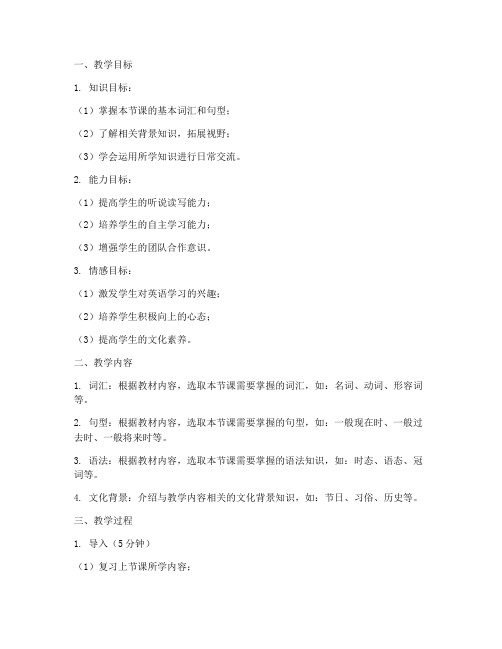
一、教学目标1. 知识目标:(1)掌握本节课的基本词汇和句型;(2)了解相关背景知识,拓展视野;(3)学会运用所学知识进行日常交流。
2. 能力目标:(1)提高学生的听说读写能力;(2)培养学生的自主学习能力;(3)增强学生的团队合作意识。
3. 情感目标:(1)激发学生对英语学习的兴趣;(2)培养学生积极向上的心态;(3)提高学生的文化素养。
二、教学内容1. 词汇:根据教材内容,选取本节课需要掌握的词汇,如:名词、动词、形容词等。
2. 句型:根据教材内容,选取本节课需要掌握的句型,如:一般现在时、一般过去时、一般将来时等。
3. 语法:根据教材内容,选取本节课需要掌握的语法知识,如:时态、语态、冠词等。
4. 文化背景:介绍与教学内容相关的文化背景知识,如:节日、习俗、历史等。
三、教学过程1. 导入(5分钟)(1)复习上节课所学内容;(2)通过图片、视频等手段引入本节课主题。
2. 新课导入(10分钟)(1)讲解本节课词汇和句型;(2)举例说明词汇和句型的用法。
3. 语法讲解(10分钟)(1)讲解本节课语法知识;(2)通过例句让学生理解语法规则。
4. 练习环节(15分钟)(1)进行词汇、句型和语法练习;(2)分组讨论,互相纠正错误。
5. 文化背景介绍(5分钟)(1)介绍与教学内容相关的文化背景知识;(2)通过讨论,加深学生对文化背景的理解。
6. 总结(5分钟)(1)对本节课所学内容进行总结;(2)布置课后作业。
四、教学评价1. 课堂表现:观察学生在课堂上的参与度、积极性、合作精神等。
2. 作业完成情况:检查学生课后作业的完成质量。
3. 课堂测试:通过课堂测试,了解学生对本节课所学知识的掌握程度。
五、教学反思1. 教学内容是否合理,是否符合学生的认知水平;2. 教学方法是否有效,能否激发学生的学习兴趣;3. 教学过程中是否存在不足,如何改进。
六、教学资源1. 教材;2. 多媒体课件;3. 图片、视频等教学辅助材料;4. 课后作业资料。
大学讲课英语翻译教案怎么写
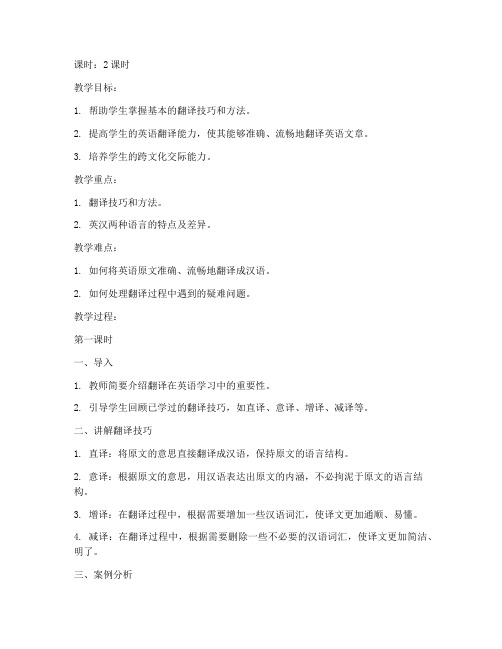
课时:2课时教学目标:1. 帮助学生掌握基本的翻译技巧和方法。
2. 提高学生的英语翻译能力,使其能够准确、流畅地翻译英语文章。
3. 培养学生的跨文化交际能力。
教学重点:1. 翻译技巧和方法。
2. 英汉两种语言的特点及差异。
教学难点:1. 如何将英语原文准确、流畅地翻译成汉语。
2. 如何处理翻译过程中遇到的疑难问题。
教学过程:第一课时一、导入1. 教师简要介绍翻译在英语学习中的重要性。
2. 引导学生回顾已学过的翻译技巧,如直译、意译、增译、减译等。
二、讲解翻译技巧1. 直译:将原文的意思直接翻译成汉语,保持原文的语言结构。
2. 意译:根据原文的意思,用汉语表达出原文的内涵,不必拘泥于原文的语言结构。
3. 增译:在翻译过程中,根据需要增加一些汉语词汇,使译文更加通顺、易懂。
4. 减译:在翻译过程中,根据需要删除一些不必要的汉语词汇,使译文更加简洁、明了。
三、案例分析1. 教师选取一篇英语文章,让学生进行翻译练习。
2. 学生分组讨论,分享自己的翻译方法和心得。
3. 教师点评学生的翻译,指出优点和不足。
四、课堂小结1. 总结本节课所学的翻译技巧。
2. 强调翻译过程中应注意的问题。
第二课时一、复习上节课所学内容1. 教师提问,检查学生对翻译技巧的掌握情况。
2. 学生回答问题,分享自己的学习心得。
二、讲解英汉两种语言的特点及差异1. 语法结构:英语和汉语在语法结构上存在较大差异,如英语的主谓宾结构、汉语的主谓结构等。
2. 词汇:英语和汉语的词汇在意义和用法上存在差异,如英语的名词前往往有冠词,而汉语中冠词使用较少。
3. 语境:英语和汉语在语境表达上存在差异,如英语中常用介词短语,而汉语中常用动词短语。
三、案例分析1. 教师选取一篇英语文章,要求学生运用所学的翻译技巧进行翻译。
2. 学生分组讨论,分享自己的翻译方法和心得。
3. 教师点评学生的翻译,指出优点和不足。
四、课堂小结1. 总结本节课所学的翻译技巧和英汉两种语言的特点及差异。
大学英语翻译课教案模板

课程名称:大学英语翻译授课班级:XX级XX班授课教师:XXX授课时间:XX课时教学目标:1. 提高学生的英语翻译能力,包括词汇、语法、句型结构和翻译技巧。
2. 培养学生运用英语进行跨文化交流的能力。
3. 增强学生对不同文化背景下的语言表达的理解和适应能力。
教学内容:1. 翻译基础知识2. 翻译技巧与方法3. 不同文体翻译4. 翻译实践与案例分析教学过程:一、导入1. 复习上节课所学内容,检查学生对翻译基础知识的掌握情况。
2. 引导学生思考:翻译的重要性以及如何提高翻译能力。
二、讲解与示范1. 讲解翻译基础知识,包括词汇、语法、句型结构等。
2. 结合实例,讲解翻译技巧与方法,如直译、意译、增译、省译等。
3. 介绍不同文体的翻译特点,如文学翻译、科技翻译、商务翻译等。
三、翻译实践1. 学生分组,每组选取一篇翻译材料,进行翻译练习。
2. 教师巡回指导,解答学生在翻译过程中遇到的问题。
3. 各组提交翻译作品,教师进行点评和总结。
四、案例分析1. 选择具有代表性的翻译案例,如经典文学作品、时事新闻等。
2. 分析案例中的翻译技巧和策略,引导学生思考如何提高翻译质量。
3. 学生分组讨论,提出自己的观点和看法。
五、总结与反思1. 教师对本节课所学内容进行总结,强调重点和难点。
2. 学生分享自己在翻译实践中的收获和体会。
3. 教师布置课后作业,要求学生巩固所学知识。
教学资源:1. 教材:《大学英语翻译》2. 辅助教材:《英语翻译技巧》3. 网络资源:英语翻译相关网站、翻译案例库等教学评价:1. 学生对翻译基础知识的掌握程度。
2. 学生在翻译实践中的表现,如翻译速度、准确性、流畅性等。
3. 学生对案例分析的理解和讨论能力。
教学反思:1. 教师根据学生的反馈,调整教学方法和内容。
2. 教师关注学生的个体差异,提供针对性的指导。
3. 教师鼓励学生积极参与课堂活动,提高学习兴趣和积极性。
专业英语翻译教案
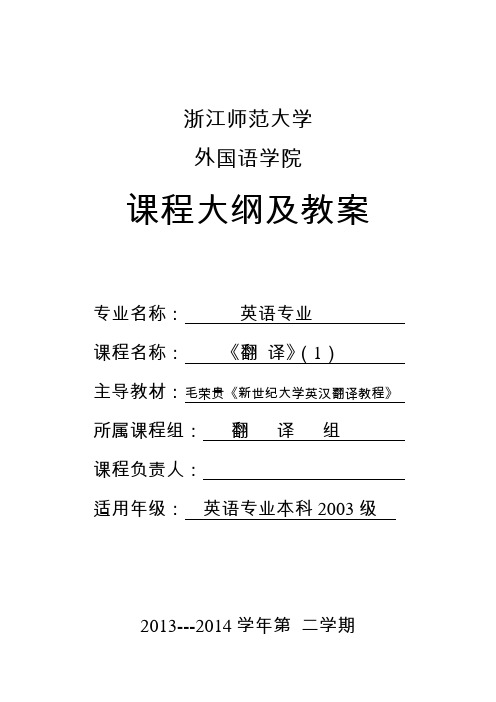
浙江师范大学外国语学院课程大纲及教案专业名称:英语专业课程名称:《翻译》(1)主导教材:毛荣贵《新世纪大学英汉翻译教程》所属课程组:翻译组课程负责人:适用年级:英语专业本科2003级2013---2014学年第二学期翻译(1)(2)课程大纲一、课程概况课程名称:翻译课程类别:专业基础课课程编号:030903081,030903082 学分:4 学时:68 开课学期:五、六二、课程教学目标和要求1、[教学目标]通过本课程的教学,帮助学生有效提高翻译实践能力和理论认识,达到高等学校英语专业英语教学大纲对其翻译能力的基本要求,即:能运用翻译理论与技巧,将英美报刊上的文章以及文学原著译成汉语,或将我国报刊、杂志上的文章和一般文学作品译成英语,译文忠实、流畅,译速每小时250-300个英文单词汉字,使之可以胜任未来的中学英语教学以及其他涉及翻译能力的工作。
2、[课程要求]本课程为系列专业基础课,由英译汉和汉译英组成,要求学生按顺序修读。
为达到课程教学的目的,采用讲练结合的方式,布臵相当数量的课后作业要求学生按时按量完成,并积极参与课堂讨论。
三、教学内容与教学安排1、[教学内容要点]本课程教学以实践为主,理论为辅,重点是翻译技巧的介绍与练笔,翻译内容涉及各类文体、各个领域。
课程安排按照讲练结合的原则展开,帮助学生有步骤有针对性地训练翻译的基本技能。
通过大量的练习和讲评,强化学生对不同文本语体特点和翻译原则的认识,为其将来从事翻译工作或运用英语作为工作语言打下坚实的双语转换实践基础。
2、[教学安排]本课程教学依据教学大纲,安排在本科三年级上、下两学期进行,共计68学时,其中36学时为英译汉,32学时为汉译英,每周2学时。
教学计划允许授课教师在具体操作中有一定的灵活度,但至少应包含以下3部分的主题内容:1)翻译概述(含翻译的标准、原则、过程、中外翻译简史及翻译名家的主要观点等);2)翻译技巧讲练(介绍主要的英汉互译技巧,结合学生的练笔进行讲评);3)多视角的翻译实践与研究(不同领域的翻译实践及其操作原则与技巧,如外来词翻译、报刊标题及新闻翻译、旅游翻译、科技翻译、广告翻译、文化与翻译等;在实践的基础上开始涉猎翻译的前沿理论,提高学生对翻译的理性认识,目的在于训练其解决问题的探索能力,为其将来从事翻译实践或理论研究开辟一个窗口)。
专业英语翻译教案.
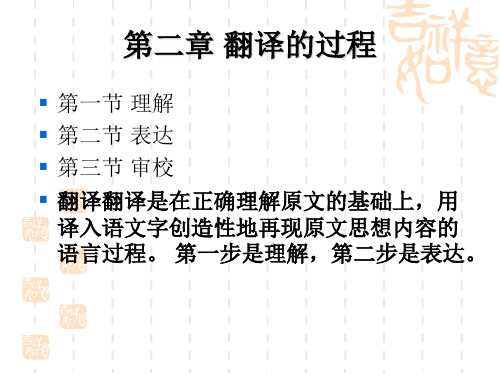
It’s a good machine that works without power.
再好的机器没有动力也不能工作。 (没有动力也能工作的机器才是好机 器。)
All his letter were not received. 他的信并eye 神枪手(不是死眼) dog ear (书页的)折角(不是狗耳朵) dry goods 纺织品(不是干货) hand money 定金,保证金(不是手中之才) honey cooler 讨好女人的男人(不是甜冷饮) man-of-war 军舰(不是军人) machine-tool 机床(不是机械工具) night cart 粪车(不是夜车) red tape 官僚主义(不是红色带子) street woman 妓女(不是街道妇女) sweet water 淡水、食用水(不是甜水) white city 游乐场(不是白色恐怖下的城市) white day 吉日(不是白天)
We cannot pay too high a price for our national security. 为了国家的安全花再大的代价也值得。(我们不能为国家的安全而花
太大的代价)
It is eight months since she taught English. 她不教英语已有八个月的时间了。(她教英语已有八个月的时间了) It is two years since I smoked. 我戒烟已有两年了。 I haven’t written to her since she lived in Beijing. 自从她离开北京以来,我一直没有给她写信。(lived是持续性动词
专业英语翻译教案
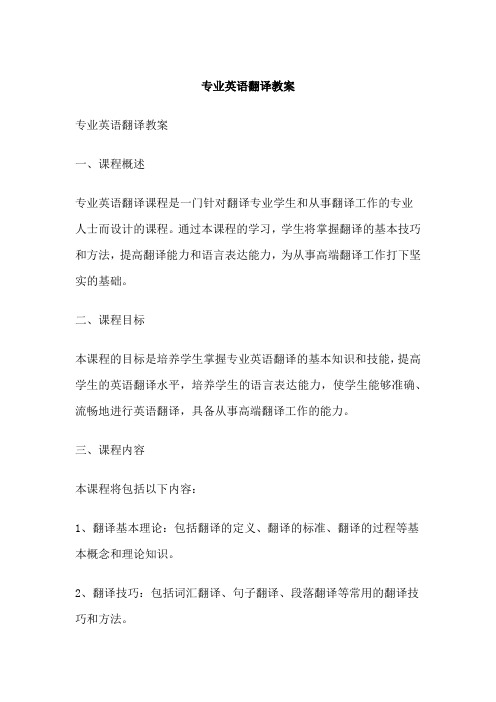
专业英语翻译教案专业英语翻译教案一、课程概述专业英语翻译课程是一门针对翻译专业学生和从事翻译工作的专业人士而设计的课程。
通过本课程的学习,学生将掌握翻译的基本技巧和方法,提高翻译能力和语言表达能力,为从事高端翻译工作打下坚实的基础。
二、课程目标本课程的目标是培养学生掌握专业英语翻译的基本知识和技能,提高学生的英语翻译水平,培养学生的语言表达能力,使学生能够准确、流畅地进行英语翻译,具备从事高端翻译工作的能力。
三、课程内容本课程将包括以下内容:1、翻译基本理论:包括翻译的定义、翻译的标准、翻译的过程等基本概念和理论知识。
2、翻译技巧:包括词汇翻译、句子翻译、段落翻译等常用的翻译技巧和方法。
3、不同领域的翻译实践:包括科技、医学、法律、商务等领域的翻译实践,让学生了解不同领域翻译的特点和技巧。
4、翻译实践:学生将进行大量的翻译实践,包括句子、段落、文章等的翻译,以提高学生的翻译能力和语言表达能力。
四、教学方法本课程将采用以下教学方法:1、理论教学:教师将通过讲解和演示的方式,传授翻译的基本理论和技巧。
2、实践教学:学生将通过大量的翻译实践,掌握翻译技巧和方法,提高翻译能力和语言表达能力。
3、小组讨论:学生将分组进行讨论,分享翻译经验和技巧,解决问题和提高翻译能力。
4、案例分析:教师将通过分析真实的翻译案例,让学生了解翻译实践中遇到的问题和解决方法。
五、评估方式本课程的评估方式将包括以下方面:1、平时成绩:包括学生的出勤率、课堂表现、作业完成情况等。
2、期末考试:通过笔试和口试的方式,评估学生的翻译能力和语言表达能力。
3、翻译实践:学生将完成一定数量的翻译实践,评估其翻译质量和表达能力。
六、教学资源本课程将利用以下教学资源:1、教材:选择一本权威的翻译教材,作为课程的主要参考教材。
2、参考书:推荐一些相关的参考书籍和资料,以便学生拓展知识和提高技能。
3、网络资源:提供一些相关的网络资源,如翻译论坛、在线词典等,帮助学生解决翻译实践中遇到的问题。
英语翻译教学教学教案

英语翻译教学教学教案英语翻译教学教案一、教学目标1. 帮助学生了解英语翻译的基本原理和技巧;2. 提高学生的英语翻译能力,包括英译汉和汉译英;3. 培养学生的翻译思维和创新能力;4. 培养学生对不同文化间的理解和应用。
二、教学准备1. 教材:教师自备相关英语翻译资料,如课外参考书、报纸、杂志等;2. 资源:计算机、投影仪、网络等;3. 教具:黑板、粉笔、英汉词典、课件等。
三、教学流程1. Warm-up活动介绍英语翻译的重要性,并与学生讨论影响正确翻译的因素。
2. 基础知识教学2.1 英译汉基本技巧a. 从句子结构和语法的角度分析英译汉的常用方法;b. 强调准确理解原文意思并寻找合适的中文表达方式;c. 提示学生在翻译过程中注意文化差异和习惯表达方式的差异。
2.2 汉译英基本技巧a. 分析汉语句子结构和语法规则的基础上进行汉译英;b. 培养学生灵活运用英语词汇和语法知识的能力;c. 强调准确表达意思并注意语言风格、时态等方面的差异。
3. 实践演练3.1 阅读翻译练习a. 提供一段英文文章让学生阅读,然后翻译成中文;b. 分组讨论、互相比较不同译文的优缺点,学生进行讲评。
3.2 书面翻译练习a. 分发一篇汉语文章,要求学生翻译成英文;b. 学生分组进行互评,教师进行点评并给予建议。
4. 拓展应用4.1 图片翻译a. 展示一张图片或者海报,要求学生分组翻译相关的英语文本;b. 学生展示自己的译文,并进行讨论和评价。
4.2 文化差异理解a. 介绍不同国家或地区的节日、习俗、美食等相关知识;b. 提示学生翻译时应注意文化背景和语言习惯的差异。
5. 总结归纳总结本节课的教学内容,并与学生一起讨论遇到的问题和收获。
四、课后作业完成指定的翻译练习,并撰写一篇学习心得。
五、教学反思本节课通过讲授英语翻译的基本原理和技巧,帮助学生提高了翻译能力。
通过实践演练和拓展应用活动,培养了学生的翻译思维和创新能力。
在讲解过程中,应注意呈现清晰、简洁的语言,以保持学生的注意力。
- 1、下载文档前请自行甄别文档内容的完整性,平台不提供额外的编辑、内容补充、找答案等附加服务。
- 2、"仅部分预览"的文档,不可在线预览部分如存在完整性等问题,可反馈申请退款(可完整预览的文档不适用该条件!)。
- 3、如文档侵犯您的权益,请联系客服反馈,我们会尽快为您处理(人工客服工作时间:9:00-18:30)。
浙江师范大学外国语学院课程大纲及教案专业名称:英语专业课程名称:《翻译》(1)主导教材:毛荣贵《新世纪大学英汉翻译教程》所属课程组:翻译组课程负责人:适用年级:英语专业本科2003级200 5 —200 6 学年第一学期翻译(1)(2)课程大纲一、课程概况课程名称:翻译课程类别:专业基础课课程编号:030903081,030903082学分:4 学时:68 开课学期:五、六二、课程教学目标和要求1、[教学目标]通过本课程的教学,帮助学生有效提高翻译实践能力和理论认识,达到高等学校英语专业英语教学大纲对其翻译能力的基本要求,即:能运用翻译理论与技巧,将英美报刊上的文章以及文学原著译成汉语,或将我国报刊、杂志上的文章和一般文学作品译成英语,译文忠实、流畅,译速每小时250-300个英文单词汉字,使之可以胜任未来的中学英语教学以及其他涉及翻译能力的工作。
2、[课程要求]本课程为系列专业基础课,由英译汉和汉译英组成,要求学生按顺序修读。
为达到课程教学的目的,采用讲练结合的方式,布置相当数量的课后作业要求学生按时按量完成,并积极参与课堂讨论。
三、教学内容与教学安排1、[教学内容要点]本课程教学以实践为主,理论为辅,重点是翻译技巧的介绍与练笔,翻译内容涉及各类文体、各个领域。
课程安排按照讲练结合的原则展开,帮助学生有步骤有针对性地训练翻译的基本技能。
通过大量的练习和讲评,强化学生对不同文本语体特点和翻译原则的认识,为其将来从事翻译工作或运用英语作为工作语言打下坚实的双语转换实践基础。
2、[教学安排]本课程教学依据教学大纲,安排在本科三年级上、下两学期进行,共计68学时,其中36学时为英译汉,32学时为汉译英,每周2学时。
教学计划允许授课教师在具体操作中有一定的灵活度,但至少应包含以下3部分的主题内容:1)翻译概述(含翻译的标准、原则、过程、中外翻译简史及翻译名家的主要观点等);2)翻译技巧讲练(介绍主要的英汉互译技巧,结合学生的练笔进行讲评);3)多视角的翻译实践与研究(不同领域的翻译实践及其操作原则与技巧,如外来词翻译、报刊标题及新闻翻译、旅游翻译、科技翻译、广告翻译、文化与翻译等;在实践的基础上开始涉猎翻译的前沿理论,提高学生对翻译的理性认识,目的在于训练其解决问题的探索能力,为其将来从事翻译实践或理论研究开辟一个窗口)。
四、教材及主要参考资料教材:毛荣贵:《新世纪大学英汉翻译教程》,上海交通大学出版社2002年版毛荣贵:《新世纪大学汉英翻译教程》,上海交通大学出版社2002年版主要参考资料:Newmark, P. A Textbook of Translation. Shanghai: SFLEP, 2001.Nida, E. A. Language, Culture, and Translating. Shanghai: SFLEP, 1993.Nida, E. A. Language and Culture: Contexts in Translating. Shanghai: SFLEP, 2001.陈宏薇:《新实用汉译英教程》,湖北教育出版社2000年版冯庆华:《实用翻译教程》(英汉互译) ,上海外语教育出版社2002年版杨平:《名作精译—〈中国翻译〉英译汉选萃》,青岛出版社1998年版张培基:《英汉翻译教程》,上海外语教育出版社1980年版中国日报网站:《汉英最新特色词汇》,上海社会科学院出版社2002年版《中国翻译》杂志。
五、作业与考核方式作业:相关翻译练习考核方式:课程考核以平时作业和期末闭卷考试相结合的方式,考核成绩由平时作业成绩(30%)和期末考试卷面成绩(70%)组成。
Teaching Plan for Translation (1)◇Title of Lesson: A Brief Introduction to Translation Week 1◇Time Needed:Two periods(40 minutes per period)◇Teaching Objectives:1.Help the students achieve a basic understanding of translation: its nature, classification, evaluation criteria, the role of translator, etc.2.Briefly introduce to the students the development of translation in China.◇Key Teaching Points:1.The nature and evaluation criteria of translation.2.The difficulties involved in translating process.◇Difficult Teaching Points:1.The nature of translation.2.The evaluation criteria of translation.3.The influence of language / cultural barriers on translation.◇Teaching Contents:I.Discussion:●What is translation?●What is a successful translation?●What difficulties might occur in translating process?A.What is translation?1.Key words:source language(SL) / receptor language / target language(TL); reproduce; message/ information; equivalence / correspondence2.Nature of translation (Eugene A. Nida):Translation consists in reproducing in the receptor language the closest naturalequivalent of the source language message, first in terms of meaning and secondlyin terms of style.3.Classification of translation:a.Oral interpretation / written translationb.Human translation / machine translationc.Literary / scientific / political / commercial translationd.Domestication (naturalization) / foreignization (estrangement, alienation)e.Literal translation / free translationB.What is a successful translation?1.严复:信、达、雅(faithfulness, expressiveness, elegance)2.傅雷:以效果而论,翻译应当象临画一样,所求的不在形似而在神似3.钱钟书:诱、讹、化4.Eugene A. Nida: natural / close; dynamic/functional equivalenceC.What difficulties might occur in translating process?nguage / Cultural BarriersTranslatability is lower when (1) the work to be translated is quite distant both intime and space; (2) its form is very much unique; (3) the content is not shared in thetwo cultures.→Betrayal: Loss / Distortion2.Example analysis:a.东边日出西边雨,道是无晴.却有晴.。
之所如,凌万顷之茫然b.纵一苇..c.The whole sky spangled gay twinkling stars, and the Milky Way is as distinct asthough it had been washed and rubbed with snow for holiday.那么清楚地显现出来,就——整个天空点缀着繁星,快活地眨着眼。
天河..。
好像有人在过节以前用雪把它擦洗过似的.........d.He made you a highway to my bed;But I, a maid, die maiden-widowed.—Romeo and Juliet译文1:他要借你做牵引相思的桥梁可是我却要做一个独守空闺的怨女而死去。
译文2:他本要借你做捷径,登上我的床;可怜我这处女,活守寡,到死是处女。
3.In the long run there is a tendency: translation itself can convert intranslatabilityinto translatability.e.g. crocodile’s tears; science / democracyII.The Role of Translator:The craft of translator is … deeply ambivalent; it is exercised in a radical tension between impulses to facsimile and impulses to appropriate recreation.— George Steiner 译者的技艺是一个深刻的矛盾体。
这种技艺是在两种冲动的极度张力之间形成的:一方面是依样画葫芦的冲动,另一方面又有适当再创作的冲动。
A.Metaphors for translator:1. A courier of the human spirits (普希金)2. A sculptor who tries to recreate a work of painting3. A straitjacketed dancer4. A musician / an actor5.Traduttori-traditori (Translators are traitors.)B.Responsibility of translator:petent linguistic ability & bicultural knowledge2.Being as transparent as possible3.Being a good negotiatorIII.The Development of Translation in China:翻译史上的三个高峰期:1.汉至唐宋佛经的转译:支谦;鸠摩罗什;道安;玄奘2.明清以后西欧科技文化的引进:徐光启;严复;林纾;(译才并世数严林-康有为)3.五四之后的现代阶段:郭沫若;鲁迅;瞿秋白;傅雷;钱钟书IV.Homework:《新世纪大学英汉翻译教程》(P. 46)◇Title of Lesson: Contrast between English and Chinese (1) Week 2 ◇Time Needed :Two periods (40 minutes per period )◇Teaching Objectives :1. Introduce to the students some basic differences between English and Chinese.2. Briefly analyze the influence of these differences on translating.◇Key Teaching Points :The difference of language embodies the difference in thinking styles.◇Difficult Teaching Points:The embodiment of different syntactic features in translating process◇Teaching Contents:I. Thinking Style and DictionA. Insubstantial (虚)vs. Substantial (实)1. Embodimente.g. In this new year, we face momentous uncertainties: war (or wars), a weakeconomy.译:这新的一年里,我们面临着战争(乃至连续的...战争)、经济低迷等一系列...重大的不确定因素..。
